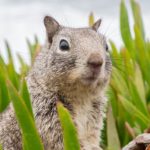Naperville
Squirrel Removal & control
relocation • exclusion • prevention
Black, grey and red squirrels are a fixture in many communities, capable of producing two litters of babies per year — one in spring and another in late summer. Squirrels can chew holes into homes and scamper within the walls and attic spaces, where they build nests, cause structural damage and pose numerous health risks.
Squirrel Removal Services
Squirrel’s have powerful teeth that never stop growing. Their strong bite can used to easily chew openings into your attic through soffits, facias and vents. The fact is that none of the materials used to construct our houses, including aluminum, vinyl and wood are no match for a squirrel’s teeth, and with small bodies they only need a two inch gap to squeeze inside gaining access to your home isn’t hard to imagine. This is made easier as our homes age and deteriorate from weather damage.
Once squirrels have made their way inside they are capable of causing costly damage to electrical and duct work , attic insulation, and even compromise the structural integrity of your home. Despite their size a squirrel’s need to chew, combined with their constant activity, can lead to extensive damage in hard to reach places. Our technicians are equipped with the professional equipment and techniques to safely reach the highest points of a home and remove hazardous materials & identify soiled insulation, chewed electrical wiring and structural damage.
When baby squirrels are present in the home, removal becomes more complicated. Squirrels have two mating seasons, with the first litter arriving between February and April, and the second in the last weeks of August and into September. During this time, young squirrels are immobile and under the watchful eye of defensive mothers. Skedaddle’s technicians are trained to safely locate squirrel babies, often with the help of thermal imaging cameras, and remove them by hand. The babies are then placed in a baby reunion box that keeps them safe and warm until their mother is removed. Once the family is reunited outside the home, and her path back in has been blocked, the mother must relocate her litter to one of her other den sites in the area.
Squirrel inspection
Here are some of the things we’ll be evaluating as part of our initial raccoon removal inspection :
- Where are the raccoons living?
- How are the raccoons getting into the house?
- Where might raccoons gain access in the future?
- What sort of damage have they caused?
- Are there babies?
Squirrel Trapping & Removal
No two squirrel removals are exactly alike. Our removal experts will use their years of experience to determine where the raccoons have made entry, where their den is located and if there are babies present.
Understanding squirrel behavior as well as home construction is key to effective removal. Hiring professionals that know which tools, techniques and strategies to use reduces property damage and saves homeowners money in the long run.
exclusion & habitate Modification
An important part of Animal Encounters Wildlife Control’s process involves securing your home against future squirrel incursions. Squirrels strong teeth, small size make exclusion challenging, but not impossible. Your wildlife technician will take the necessary steps to prevent re-entry to your home by identifying all potential entry points, and securing them as well as informing you of steps you can take to make your property less inviting to squirrels.



squirrel Removal Near You
Squirrel in the attic, or strange noises in your chimney or crawl spaces? Drop us a line!
The masked bandit is not a creature known for it’s stealth. While it doesn’t try to hide its activities from people, it is a nocturnal animal, so we don’t witness much of it’s activity. While you might know if a raccoon gets into your garbage bins, it might be harder to know if they’ve moved into your attic or taken residence in your crawl space.
Hearing animal activity at night might be one of the first signs of raccoons. Because they are large animals they tend to make a lot of noise, often sounding closer to human footsteps than animal ones. Other signs might include:
- Tracks in or around the house
- Scratch Marks
- Droppings
- Low growls & vocalizations
- Sounds of shuffling in the walls.
- Overturned Garbage cans
If you discover one of these furry little animals in your home, it is important to get ahold of the professionals for humane raccoon removal right away. Because of their size, intelligence and dexterity raccoon can seriously damage your home if left unchecked
Raccoons cause of a lot of structural damage to a house, ripping up insulation and chewing wooden beams to create their den & a safe place for their young. They’ve also been known to rip up roof tiles in order to gain access, this can lead to water damage and costly repairs.
Besides damage to your home, raccoons also pose a health hazard to your family. Diseases such as leptospirosis, salmonella & racoon roundworm are carried in fecal matter and urine. Pets and children who play in the yard bear the most risk of illness due to raccoon infestation.
Although raccoons might be adorable, it’s best to take steps to deter them from your yard avoiding damage to your home, messes left behind and possible illness.
- Remove possible food sources
- Secure trash cans
- Block access to hiding places
- Eliminate possible water sources
- treat your lawn for grubs regularly
- Install Motion activated lights
Call a professional right away if you believe you have a raccoon living on your property.
